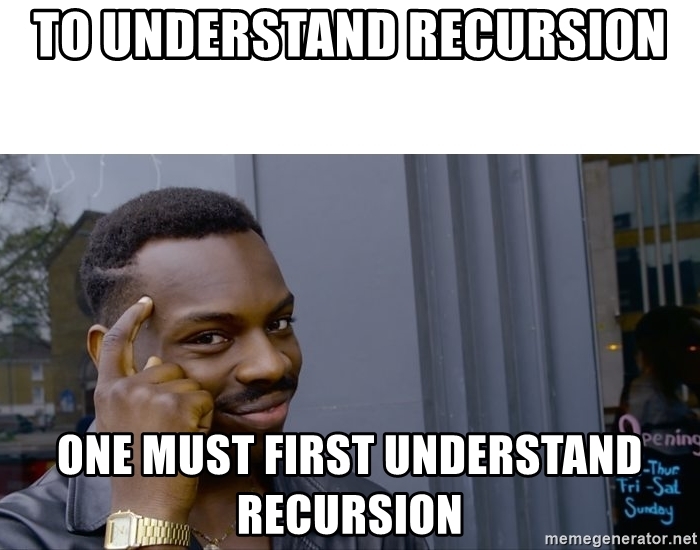def fact(n: int) -> int:
if not n: # Pythonic zero check
return 1 # Base case
return n * fact(n-1) # Inductive case/RecursionRecursion
Introduction to Software Engineering (CSSE 1001)
Recursion
When a function calls itself it is classified as a recursive function.
This may seem strange because we are using the function to define the function but this is logically sound.
Memes
Induction
Recursion is essentially an implementation/realization of mathematical induction.
You will not be tested, nor must you really understand, induction. It is just motivation.
Theorem 1 (The Principle of Mathematical Induction) For any predicate \(P : \mathbb{N} \to \{\text{True}, \text{False}\}\) \[ (P(0) \land (P(n) \implies P(n+1))) \implies \forall m \in \mathbb{N}, P(m) \]
In prose this means: if
- the proposition is true for zero, and
- if the proposition is true for \(n\) then it is also true for \(n+1\),
then \(P(n)\) is true in general.
Tiling
A standard chess board can be filled with ‘corner-tiles’ so that only one space is left uncovered and no tiles overlap.
Here is one such tiling:
where the disc shows the (arbitrary) location of the uncovered square.
Proposition 1 Any \(2^n \times 2^n\) board with \(n \in \mathbb{N}\) can be tiled so that only one square is left uncovered.
Proof. Base Case We can cover a \(2^0 \times 2^0 = 1 \times 1\) board with zero tiles:
Induction Hypothesis Assume a \(2^n \times 2^n\) board can be tiled.
We can tile a \(2^{n+1} \times 2^{n+1}\) board because, by our assumption, tilings for \(2^n \times 2^n\) board exists.
Recursion Ingredients
Every recursion must have at least one of each of the following.
Base Case A case which is defined outright. That is,
if base_case:
return constantRecursive Step A line where the function calls itself on “smaller” input.
Factorial
The canonical example for a recursive function is the factorial.
Let \(n \in \mathbb{N}\) then the factorial of \(n\), denoted \(n!\) is given by \[ n! = \begin{cases} 1 & \text{when } n = 0\\ n \times (n-1)! & \text{otherwise} \end{cases} \] For instance \(3! = 3 \times 2 \times 1 \times 1 = 6\).
Side-note: A set of \(n\) distinct elements can be arranged in \(n!\) different ways.
fact(0) 1fact(3) 6fact(-1) RecursionError: maximum recursion depth exceeded # Bottoming outWinding
Here is how our fact code is evaluated for \(n=4\). \[
\begin{align*}
\MoveEqLeft\mbox{factorial}(4) \\
&\gets 4 \times \mbox{factorial}(3)\\
&\gets 4 \times (3 \times \mbox{factorial}(2))\\
&\gets 4 \times (3 \times (2 \times \mbox{factorial}(1)))\\
&\gets 4 \times (3 \times (2 \times (1 \times \mbox{factorial}(0))))
\end{align*}
\] This is called the winding phase of the evaluation process.
During the winding phase, new recursive calls build a stack of activation records that complete last in first out.
Note: A stack would be drawn in the reverse order.
Unwinding
After winding we do unwinding. \[ \begin{align*} \MoveEqLeft \mbox{factorial}(4) && \mbox{winding} \\ &\;\;\vdots &&\;\;\;\;\;\vdots \\ &\gets 4 \times (3 \times (2 \times (1 \times \mbox{factorial}(0)))) && \mbox{winding} \\ &\gets 4 \times (3 \times (2 \times (1 \times 1))) &&\mbox{unwinding} \\ &\gets 4 \times (3 \times (2 \times 1)) &&\;\;\;\;\;\vdots \\ &\gets 4 \times (3 \times 2)&&\;\;\;\;\;\vdots \\ &\gets 4 \times 6&&\;\;\;\;\;\vdots \\ &\gets 24 && \mbox{unwinding} \end{align*} \]
Stack Overflow
Python will only allow a finite many recursive calls to be made. We say the recursion has overflowed when you exceed this limit.
Exceeding the stack limit does not necessarily mean we are bottoming out. Rather, our algorithms may legitimately require more stacks than what Python provides by default.
To increase the stack limit do, for instance
import sys
sys.setrecursionlimit(1500) # default is 1000
fact(1000) 402387260077093773543702433923003985719374864210714632543799910429938512398629020592044208486969404800479988610197196058631666872994808558901323829669944590997424504087073759918823627727188732519779505950995276120874975462497043601418278094646496291056393887437886487337119181045825783647849977012476632889835955735432513185323958463075557409114262417474349347553428646576611667797396668820291207379143853719588249808126867838374559731746136085379534524221586593201928090878297308431392844403281231558611036976801357304216168747609675871348312025478589320767169132448426236131412508780208000261683151027341827977704784635868170164365024153691398281264810213092761244896359928705114964975419909342221566832572080821333186116811553615836546984046708975602900950537616475847728421889679646244945160765353408198901385442487984959953319101723355556602139450399736280750137837615307127761926849034352625200015888535147331611702103968175921510907788019393178114194545257223865541461062892187960223838971476088506276862967146674697562911234082439208160153780889893964518263243671616762179168909779911903754031274622289988005195444414282012187361745992642956581746628302955570299024324153181617210465832036786906117260158783520751516284225540265170483304226143974286933061690897968482590125458327168226458066526769958652682272807075781391858178889652208164348344825993266043367660176999612831860788386150279465955131156552036093988180612138558600301435694527224206344631797460594682573103790084024432438465657245014402821885252470935190620929023136493273497565513958720559654228749774011413346962715422845862377387538230483865688976461927383814900140767310446640259899490222221765904339901886018566526485061799702356193897017860040811889729918311021171229845901641921068884387121855646124960798722908519296819372388642614839657382291123125024186649353143970137428531926649875337218940694281434118520158014123344828015051399694290153483077644569099073152433278288269864602789864321139083506217095002597389863554277196742822248757586765752344220207573630569498825087968928162753848863396909959826280956121450994871701244516461260379029309120889086942028510640182154399457156805941872748998094254742173582401063677404595741785160829230135358081840096996372524230560855903700624271243416909004153690105933983835777939410970027753472000000000000000000000000000000000000000000000000000000000000000000000000000000000000000000000000000000000000000000000000000000000000000000000000000000000000000000000000000000000000000000000000000000000000000000000000000000000000000000000000000000000fact(2000)RecursionError: maximum recursion depth exceededfact(-1) RecursionError: maximum recursion depth exceededNon-Obvious Base Case
To handle non-obvious base cases consider an example that makes a single recursive call.
Ask what the base case must be in order for your example to work.
For example, consider \[ 2^k = 2 \cdot 2^{k-1} = 2 \times \cdots \times 2 \text{ $k$-many times} \]
What does 0-many times mean?
Notice we have \(2^1 = 2\) and \(2^1 = 2 \cdot 2^0\) and therefore \(2^0 = 1\).
Recursive functions defined over lists and strings usually have as their base case the empty list and the empty string.
| Type | Base Case |
|---|---|
list |
[] |
str |
'' |
dict |
{} |
Exercises
Let us now solve problems using recursion.
Ask yourself how you would solve the problem if you could solve the same problem on smaller examples.
When in doubt, set the base cases to what they need to be in order for the singleton case to work. The singleton case is the second smallest one.
Exercise 1 Determine if a string is a palindrome. That is, a word that is equal to its reverse.
def is_palindrome(cs: str) -> bool:
"""
Return True only when <cs> is a palindrome.
>>> is_palindrome("dad")
True
>>> is_palindrome("racecar")
True
>>> is_palindrome("yo, banana boy!")
False
"""Note there is an obvious answer
def is_palindrome(cs: str) -> True:
return cs == cs[::-1]but suppose we want to avoid reverising a list.
We could do the following which requires some index arithmetic.
def is_palindrome(cs: str) -> bool:
for k in range(len(cs)//2):
if cs[k] != cs[-k-1]:
return False
return True But with recursion the arithmetic is more simple.
def is_palindrome(cs: str) -> bool:
if not cs: # base case
return True
return cs[0] == cs[-1] and is_palindrome(cs[1:-1])
# recursionExercise 2 Determine if a sentence is a palindrome, ignoring spacing, casing, and punctuation.
def sentence_palindrome(cs: str) -> bool:
"""
>>> sentence_palindrome("Al lets Della call Ed `Stella'.")
True
>>> sentence_palindrome("Yo, banana boy!")
True
"""Exercise 3 Flatten a list. That is, remove all internal brackets.
def flatten(xs: list) -> list:
"""
Return the list obtained by removing all internal brackets
from <xs>
>>> flatten([1, [2], [[3,4]], [[5], [6, 7, 8], 9]])
[1, 2, 3, 4, 5, 6, 7, 8, 9]
>>> flatten([[1, 2, 3], [4, [5, 6]]])
[1, 2, 3, 4, 5, 6]
"""Exercise 4 Check if a list of numbers is monotonically increasing.
def mono_inc(xs: list[int]) -> bool:
"""
Return True when the members of <xs> are monotonically increasing.
>>> mono_inc([1, 2, 3])
True
>>> mono_inc([1, 1, 1])
False
>>> mono_inc([3, 2, 1])
False
"""Exercise 5 Sum the digits of a number. I.e., the sum of the digits 123 is 1+2+3=6.
def sum_digits(x: int) -> int:
"""
Return the sum of the digits of <x>.
>>> sum_digits(1234)
10
>>> sum_digits(7)
7
"""Exercise 6 Determine if xs: List[int] has a sublist that sums to some target.
def sum_digits(x: int) -> int:
"""
Return the sum of the digits of <x>.
>>> sum_digits(1234)
10
>>> sum_digits(7)
7
"""Exercise 7 Suppose you are standing on a grid at the origin and can only move along the x and y axis by positive increments.
How many distinct paths are there to an arbitrary position on the grid?
Exercise 8 Return a solution to the Towers of Hanoi problem.
Exercise 9 The string "abc" has eight substrings: "", "a", "b", "c", "ab", "ac", "bc", "abc".
Write a function that given two strings, returns the longest common subsequence of those two strings.
def lcs(xs: str, ys: str) -> str:
"""
>>> lcs("cbfbcdeb", "cbebcee")
'cbbce'
"""Dynamic Programming
One problem with recursion is its efficiency with branching recursions.
There is a strategy of caching previous results when doing recursion that is quite powerful when the branching recursion has many overlapping sub-problems. Caching is the process of saving previous computations using a dictionary so expensive computations only need to be performed once.
Fibonacci Sequence
The Fibonacci sequence is the canonical examples for dynamic programming because many computations need to be repeated while determining computing it. The \(n\)th number of this sequence is defined to be the sum of the previous two numbers in the sequence: \[ 0, 1, 1, 2, 3, 5, 8, 13, 21, 34... \] and generally if \(F_n\) is the \(n\)th Fibonacci number then \[ F_n = F_{n-1} + F_{n-2} \] with \(F_0 = 0\) and \(F_1 = 1\).
Notice this means to obtain \(F_6\) we need to compute \(F_3\) three times because \[ \begin{align*} F_6 &= F_5 + F_4 \\ &= (F_4 + F_3) + (F_3 + F_2) \\ &= ((F_3 + F_2) + F_3) + (F_3 + F_2) \end{align*} \] and these repeated computations get worse for larger numbers. For instance, \(F_9\) is computed 1,346,269 times when computing \(F_{39}\).
def fib(n: int) -> int:
"""
Return the nth Fibonacci number.
"""
if n < 2:
return n
return fib(n-1) + fib(n-2)import timeit # library for timing functions
# Number of seconds to compute the 39th fib number
timeit.timeit(lambda: fib(39), number=1)17.43232129400002If we store previous answers, then we can do the same computation much faster.
fib_cache = {0: 1, 1: 1} # Base cases go here
def fib(n: int) -> int:
global fib_cache
# check if it is necessary to compute fib(n)
if not n in fib_cache:
# remember this computation
fib_cache[n] = fib(n-1) + fib(n-2)
# otherwise just returned the cached outcome
return fib_cache[n]import timeit # library for timing functions
# Number of seconds to compute the 39th fib number
timeit.timeit(lambda: fib(39), number=1)2.6370000000497384e-05




